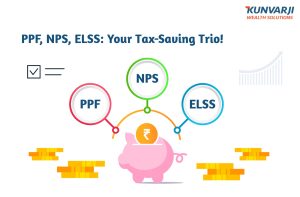Every rupee you earn holds value, and it deserves to be used wisely. By saving on taxes, you protect a part of your hard-earned money. When you combine tax saving with wealth creation, you take a step towards financial stability and future security. It is not just about saving today, but about building something meaningful for tomorrow. This is where picking the right tax-saving option becomes crucial.
Best Tax-Saving Options in India
If you have opted to file your returns under the old tax regime, here are some investment options available for you:
Public Provident Fund
The Public Provident Fund (PPF) is a long-term, government-backed savings scheme introduced under the PPF Act of 1969. You can open a PPF account via banks, post offices, or online platforms with a minimum opening balance of ₹100. The minimum investment sum is ₹500 per financial year, while the annual threshold limit is ₹1.5 lakh. You can apply for this investment only if you are an Indian resident. If you are a minor, your parents can make investments on your behalf.
PPF offers EEE tax benefits, which means your contributions qualify for tax perks under section 80C for up to ₹1.5 lakh, while the interest and maturity amounts are subject to tax exemption.
Other key features of PPF include:
· You can enjoy an interest rate of 7.1% per annum, compounded annually and revised quarterly by the government.
· PPF comes with a 15-year tenure, which is also a lock-in period. You can extend the tenure indefinitely in blocks of 5 years.
· Partial withdrawals are allowed from your investment after 5 years, up to 50% of the balance at the end of the 4th year or the year before withdrawal, whichever is lower.
· The scheme allows for premature closure only in cases of serious illness or higher education, subject to documentation and approval.
· You can also apply for a loan against your PPF after 1 year of account opening, up to 25% of the balance. If you wish to apply for a second loan, it is available only if the first one is fully repaid.
· A loan against a PPF attracts a 1% interest rate if repaid within 36 months; for repayment beyond this period, a 6% interest rate applies.
National Pension System
The National Pension System (NPS) is a voluntary and long-term retirement savings scheme regulated by the Pension Fund Regulatory and Development Authority (PFRDA). It helps individuals save systematically during their working years and receive a pension after retirement.
NPS offers two account types: Tier I (mandatory retirement account) and Tier II (voluntary savings account). Talking about the tax benefits, under Section 80CCD(1), subscribers can claim a tax deduction of up to ₹1.5 lakh (included in the ₹1.5 lakh limit under 80C).
An additional deduction of ₹50,000 is available under Section 80CCD(1B) for contributions to Tier I. Not only that, employer contributions are eligible for deduction under Section 80CCD(2), up to 10% of salary (14% for central government employees). Tier II account contributions are eligible for tax deduction under Section 80C only if the account is locked in for 3 years and the subscriber is a government employee.
Other features of NPS include:
· The scheme is available to both residents and non-resident Indians between the ages of 18 and 70. However, OCI cardholders, Persons of Indian Origin (PIOs), and Hindu Undivided Families (HUFs) are not eligible.
· Minimum contribution for Tier I is ₹500 to open an account and ₹1,000 per year to keep the account active. The minimum contribution for Tier II is ₹250 per transaction, with no minimum annual balance requirement.
· Returns are market-linked and vary based on asset allocation, historically ranging from 11% to 20% annually.
· Funds are managed by PFRDA-approved fund managers, who invest in corporate bonds, equity, and government securities.
· For a Tier I account, withdrawals before age 60 are allowed up to 25% of self-contributions for purposes such as a child’s higher education, a child’s marriage, house purchase or construction, or treatment of critical illnesses.
· A maximum of three partial withdrawals is allowed before retirement, with a mandatory 5-year gap between each, except in medical emergencies. Withdrawals from a Tier II account are unrestricted.
· At retirement or upon exiting at age 60, you can withdraw 60% of the total corpus, which will be tax-free. The remaining 40% is utilised by buying an annuity plan, which provides taxable pension income.
· Parents or guardians can open NPS accounts for minor children under the NPS Vatsalya option.
· As a subscriber, you must choose a scheme preference between Active Choice and Auto Choice. In Active Choice, you decide the allocation across asset classes. In Auto Choice, the asset allocation is automatically adjusted based on the subscriber’s age.
Equity Linked Savings Scheme
An Equity Linked Savings Scheme (ELSS) is a type of diversified equity mutual fund in India that qualifies for tax deductions of up to ₹1.5 lakh under Section 80C. It combines tax-saving
benefits with wealth creation potential by investing primarily in equities and equity-related instruments. Long-term capital gains (LTCG) above ₹1.25 lakh in a financial year are taxed at 12.5%. Dividends, if any, are taxed as per your income tax slab.
Other features of ELSS include:
· It has a mandatory lock-in period of 3 years, which is the shortest among all 80C options.
· You can invest either as a lump sum or through a Systematic Investment Plan (SIP).
· The minimum investment amount ranges from ₹500 to ₹1,000, depending on the fund house. There is no upper limit on investment.
· Returns are market-linked and are based on the performance of the stock market.
· The portfolio is spread across large-cap, mid-cap, and small-cap stocks across sectors.
· Redemption is only allowed after 3 years from the date of investment. Premature exit is not permitted.
Conclusion
EPF, NPS, and ELSS all offer tax benefits but differ in structure and flexibility. EPF provides EEE (Exempt-Exempt-Exempt) status, making it fully tax-free and ideal for salaried employees. NPS offers additional tax deduction under Section 80CCD(1B) up to ₹50,000, but only 60% of the corpus is tax-free on maturity. ELSS qualifies for Section 80C benefits up to ₹1.5 lakh, with a 3-year lock-in and 12.5% LTCG tax on gains above ₹1.25 lakh. For conservative investors, EPF is the best option. If you seek higher returns with partial risk, go for ELSS. For retirement-focused, tax-efficient planning, NPS stands out. Select options based on your risk tolerance, liquidity requirements, and retirement objectives.







